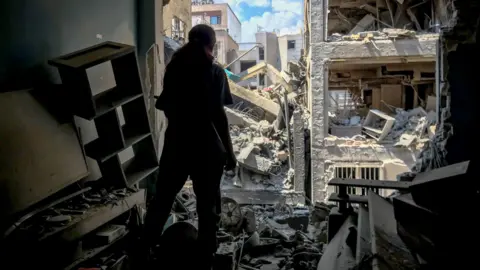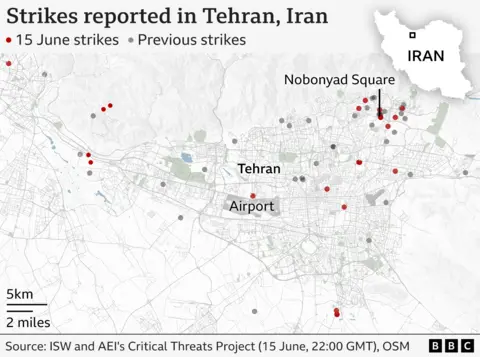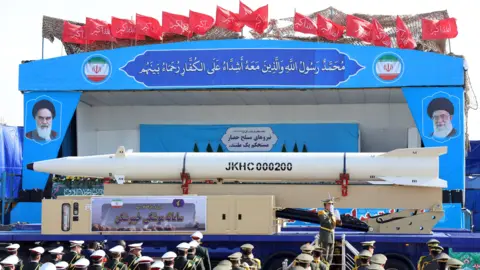Jonathan Beale
Defence correspondent

 Getty Images
Getty Images
A woman looks out of her bomb-damaged flat in Tehran
Israel's conflict with Iran may look like a mismatch on paper - a nation of nine million people taking on a giant of the Middle East, home to 88 million.
But Israel's formidable and sophisticated military forces - with an arsenal largely, but not exclusively, provided by the United States - are enabling it to overpower a much larger enemy.
The BBC looks at the military balance in the latest war in the Middle East.
What has Israel achieved so far?
Israel already says it has gained control over the skies over Tehran. It has been a complete mismatch in the air - with no sign of Iran's few ageing fighter jets even getting off the ground.
Israel's fleet of modern, US-made fighters have been able to drop guided bombs from short range - with apparently little concern of being shot down.
Much of the threat from Iran's air defences was destroyed in an earlier Israeli strike in October - using longer range "stand-off" weapons to target Iran's S300 missile systems.
In recent days Israel's air force has continued to target ground-based radar and launchers. Even before the attack got under way, Israel had intelligence operatives inside Iran preparing to disrupt its response.
Mossad agents used drones smuggled into the country to target Iran's remaining air defence systems.
Israeli attacks also wiped out many in Iran's top level of command, which would have also undermined Iran's response.


Is Iran still able to strike back?
Before Israel began its attacks, Iran had what the US described as the "largest ballistic missile arsenal" in the Middle East.
Estimates vary from between 2,000 to 3,000. Some of those, and the factories in which they were produced, have already been hit by Israel. The IDF also says it has destroyed a third of Iran's surface-to-surface launchers.
Nevertheless, Tehran has still been able to fire wave after wave of missiles into Israel, and some have penetrated its sophisticated air defences.
The Israeli military says it has now destroyed a third of Iran's surface to surface launchers. But while Iran's missile programme will have been degraded, it has not been destroyed. It remains the greatest direct threat to Israel.
And despite Israel's attacks, Iran still has many short range air defence missiles.
Justin Bronk, of the defence think tank Rusi, said that while Israel may now be able to claim air superiority over Tehran, it has still not achieved air dominance and the threat of short range missiles remain.

 EPA
EPA
The US said Iran had the biggest missile stockpile in the Middle East.
Does Iran have allies - and what could they do?
Iran has for years invested in Hamas in Gaza and Hezbollah in Lebanon with military advice, weapons and technology.
But their ability to threaten Israel on its frontiers has been greatly diminished by Israeli action over the last two years: Hamas has been all but destroyed in Gaza, and Hezbollah's potency reduced to the point where it has not responded to Israel's attack on its paymaster.
The Houthis, while more distant in Yemen, have still been able to fire the occasional salvo of missiles into Israel.
They survived a sustained US bombing campaign earlier this year, and were able to bring down several US Reaper drones with short range ground-to-air missiles.
Could other countries be dragged in?
Iran has the ability to strike western interests in the region. Iranian-backed militant groups in Iraq have targeted western military bases in the region. The US and the UK have been preparing for the worst.
There are still around 100 UK personnel based in Baghdad alongside the US military. Their safety is one reason why Kier Starmer, the British prime minister, recently ordered additional RAF Typhoon jets to Cyprus.
US and UK military naval personnel and ships are also stationed in Bahrain. The longer this war goes on the greater the risk for western forces in the region.
Iran still has the ability to disrupt or choke one of the world's main shipping lanes in the Straight of Hormuz. It may not currently seem wise for Tehran to widen the conflict, but it could do so if it chooses.

 Getty Images
Getty Images
Israel has US-made jets, like the F-35, but are they enough to achieve its goals in Iran?
Can Israel achieve its goals?
Israel has the upper hand, but the continuation of its military campaign is still largely dependent on US backing.
It receives billions of dollars of US military aid each year. Most of the weapons being fired from their American-made jets have been flown in from the US. Even some of the interceptor missiles for its own Iron Dome air defences are made in the US.
The "bunker busting" bombs Israel has been using to target Iran's underground nuclear programme are mostly US-supplied. Donald Trump, the US president, has so far been willing to back their use, though it is reported that he vetoed Israeli plans to target Iran's Supreme Leader, Ali Khamenei.
Nor has the US given Israel access to the one weapon that would probably be needed to penetrate Iran's underground nuclear complex at Fordow - the Massive Ordnance Penetrator, a 30,000lb (13,600kg) bomb, which also can only be delivered by US B2 strategic bombers.
Even with continuing US military support there will be limits to what Israel can achieve. Air power may set back Iran's nuclear programme, but it won't destroy it. Israeli hopes of toppling the Iranian regime seem highly unlikely.
Air campaigns can create fear and chaos and rubble. But think of Libya in 2011, or Israel's continuing assault on Gaza: they rarely result in a clear-cut victory.
.png)
 6 months ago
18
6 months ago
18








 English (US) ·
English (US) ·